
Author Archives: admin


Living Bioswale Technology
The Hendrikus Group has been pioneering bioswale technology for over 30 years.
Not able to find good soils when he came to America, Hendrikus designed his own soils. Knowing instinctively that the land itself is the basis for good water, soil interaction was the key. He designed his “EssentialSoil” custom soil blends accordingly; to act like bioswale engineered soil mixes that infiltrate, purify and, with the help of plants and soil microorganisms, remediate water.
He began designing and building what he calls “living bioswales” to handle problems of excessive storm water caused by urbanization, poor construction practices leaving hard compact soils everywhere, and poorly designed drainage systems that were inept to handle unpredictable weather patterns. He calls them “living” not just because they contain plants, but because the entire bioswale functions within the ecosystem of the whole site. These living bioswales promote healthy fertile soils, soil microorganisms, wildlife, and a healthy sense of beauty.
In fact, Hendrikus began to design bioswales that never looked like what most “bioswales or rain gardens” look like. His designs flow together with other elements of the garden or landscape. People are completely unaware that they are looking at an engineered drainage construction. Instead the bioswale blends in, and “lives” as the garden or land “lives”.
No Clean Soil, No Clean Water
“A rain garden”, Hendrikus will often say, “is every garden – it’s the whole garden – or it should be”. By using his EssentialSoil blends the Hendrikus group is able to turn even formal gardens or large areas of turf into sources of storm water storage by lowering the runoff rate.
Civil engineers call these “non-point” drainage systems. It remains one of the most overlooked areas of drainage on projects that rely exclusively on catch basins and piping.
Large estates can utilize a non-point approach to drainage with bioswales andoften decrease the extent of their standard drainage systems. These projects are far more “resilient” in the face of extreme weather.
A Design Imperative: Avoid Loss and Save Money
To the owners and managers of large estates this “resiliency” will actually prevent the real loss of property, home, expensive repairs, and wildly expensive corrective construction. Bioswale construction is almost always far less expensive than the “gray” standard option. Living bioswales go further by making them beautiful and long-lived, healthy and functional, even in challenging circumstances.
Abioswale here? You’re kidding!
Many of our projects involve unique challenges. One large project was built on a very complicated “knifeshaped” ridge that extended to an ocean-facing cliff. Not only was it was built on a bird sanctuary but there was almost no room to work. Another 30-acre estate had its primary residence in harms way of emergency storm runoff from its agricultural fields should the drainage system became overwhelmed.
Standard drainage systems designed from “status quo” expectations are not only very costly in these circumstances; they can actually fail to protect the owner from loss of property and land.
Engineered Synchronicity
Overall solutions in all of these cases included optimizing every part of the site in combination with an intensive living bioswale system with focused traditional “grey” stormwater piping. This involved several features that worked in synchronicity with each other to create a highly resilient site that can weather severe and unexpected storms anywhere they occur. The images here represent projects that would have incurred substantial loss if their site were not highly “resilient” to storm water.
The key is to start with the soil and end with the entire site.
3 Benefits from using Erosion Control Soils
All of these projects used EssentialSoil Erosion Soils throughout the site. These soils accomplished 3 things simultaneously. First they completely prevented erosion from occurring even without protection. Second, with a high infiltration rate, they provided a cushion or a buffer against high precipitation throughout the site that decreased the burden on any needed piping system. Third the soils promoted stability on all slopes by their own intrinsic and “internal angle of friction” and by growing very deep roots quickly.
Living Bioswales: nature’s improved catch basins
Living bio-swales accomplish three things with water; they filter, absorb and purify. Water purification takes place partially through phytoremediation, which means through plant and root growth. Absorption occurs when water slowly seeps into the ground. Filtration occurs when sediment gets trapped from plants and also settles to the bottom when the water slows down. “Grey” water systems can’t do all three things.
Despite their effectiveness, sometimes projects require what is known as a “forebay” or “backbay” system of bio-swales to accommodate storm water. One such project shown in the images uses one primary intense bio-swale next to a road, than pipes the overflow to a secondary “backbay” or living bio-swale further down the site where they was a small bit of flat land.
Living bioswales receive storm water, they infiltrate it into the ground, and purify the water through natural sediment filtration and phytoremediation. Despite their effectiveness, sometimes projects require what is known as a “forebay” or “backbay” system of bioswales to accommodate storm water. One such project shown in the images uses one primary intense bioswale next to a road, than pipes the overflow to a secondary “backbay” or living bioswalefurther down the site where there was a small bit of flat land.
Together, using highly permeable soils, with a network of living bioswales can truly make a project resilient against unpredictable storm water events.
Stop Thinking in Compartments: The Land Doesn’t Work that Way
It’s critical, however, that managers and designers do not always think in terms of engineered hydraulic capacity of drainage systems. This compartmentalized thinking excludes the land’s inherent potential to solve some of our worst storm water problems.
The land itself needs to be thought of in terms of its living resiliency to accommodating storm water. This means focusing on the entire site. It means thinking differently and thinking of the soil as part of the system and solution everywhere on-site.
Furthermore when thinking of the land not just as a solution to a problem, but as a living potentiality for celebrating, purifying, witnessing, and conserving water over time we find interesting happens:
We solve our problems even better.
This type of thinking requires new approaches to project insight management,It requires new thinking in our protocols and practices – and in our engineering and design. The projects represented in the images could not have been executed without living bioswales and our permeable soils.
Welcome to the Hendrikus group.We’ve been thinking like this for 30 years.
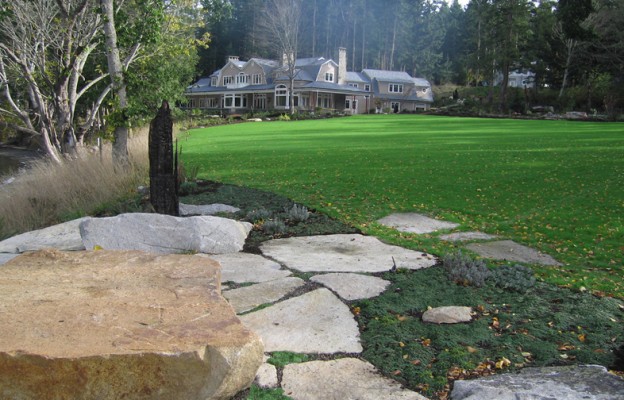
Spirit Cove Lakes, San Juan Islands, WA
[ngg_images source=”galleries” container_ids=”14″ display_type=”photocrati-nextgen_pro_slideshow” image_crop=”0″ image_pan=”1″ show_playback_controls=”0″ show_captions=”0″ caption_class=”caption_overlay_bottom” caption_height=”70″ aspect_ratio=”1″ width=”100″ width_unit=”%” transition=”fade” transition_speed=”1″ slideshow_speed=”7″ border_size=”0″ border_color=”#ffffff” ngg_triggers_display=”always” order_by=”sortorder” order_direction=”ASC” returns=”included” maximum_entity_count=”500″]
This 40-acre estate Washington’s San Juan Islands had two large challenges. The first challenge was to put back the wetlands that were removed by early development while accommodating a complicated network of watershed drainage patterns. This site was the confluence of many square miles of island watershed. When it rained, it really poured and was felt right here on this site. To complicate the matter there are many forms of wildlife that were at stake in combination with the site containing an ancient Native American graveyard. The second challenge was to create all of this with so it shone with natural beauty.
The Hendrikus Group essentially redirected the hydraulic and soils engineering of the site in order to produce a system of man-made lakes and interconnected streams. One of the smaller lakes essentially functioned as a large living bio swale.
Each island shared common values and traits involving preserving and establishing native plantings along with shoreline and local beach zone developments. Creating wildlife habitat was a major initiative. Several dead and decomposing trees were reassembled in certain areas to create forms of habitat. Considerable attention was given to bird habitat and the restocking of fish.
Because of the poor condition of soils throughout the area due to overuse and compaction, soil restoration was a center pin component for this project. A soil mixing and restoration station was set up on-site. This station both reclaimed existing compacted soils and mixed new custom EssentialSoils for use on the project. Only organic ingredients and materials were used throughout.
The extensive areas turf were installed over existing soil in which EssentialSoil was deeply cultivated to provide high infiltration rates and turf health. The concept of “non–point” drainage systems was used throughout the site to help gain control of the site resiliency and protect against the drainage and erosion failures of the past.
An innovative approach to wetland design and construction was pioneered here. The wetlands were constructed with EssentialSoils specifically developed for that use, along with various forms of bio-retention using anchored logs and geotextile fabrics. The anchored logs over time will contribute to further root growth and the establishment of micro ecosystems.
In addition to ecological pursuits this project engaged in many aesthetic concerns for the Client. Several key waterfalls were installed along with a colorful collection of plantings to accentuate seasonality. Stone bridges were constructed for their aesthetic appeal and durability. Boulders and large flat stone areas were created for visual accents, spatial design, and to create opportune areas for gathering, entertainment, and special events.
It was important that the wetlands truly look like highly diverse lush wetlands as quickly as possible. For this reason all the logs were used extensively with specific boulders and specific types of plants to create a layered, diverse old riparian and wetland ecology. The area’s wetland specialist delightedly reported that these wetlands became established approximately 5 times faster than standard wetland restoration projects.
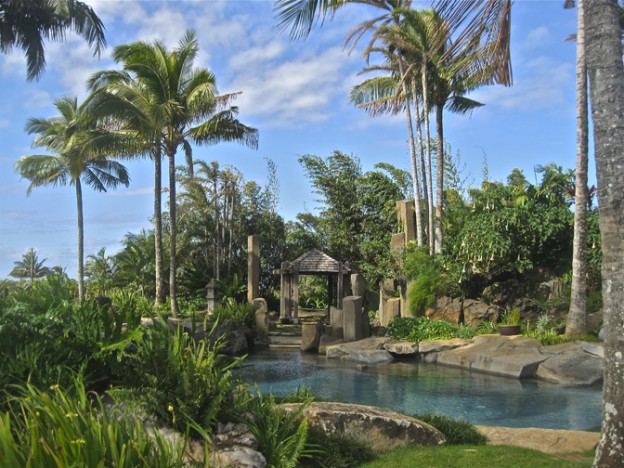
Natural Pool and Spa, Hawaii
This diverse garden “island” had the design intent to flow many intricate yet spacious-feeling elements and activities into a compact, varied, yet unified garden.
The central feature is the spacious organically-purified swimming pool and adjoining spa where carefully designed boulders encourage many activities surrounding the pool. There are places where you can ankle wade while sitting on boulders, or sit and witness the playful goings-on in the shallow end. There are boulders from which you can dive into the deep end and ones on which you can comfortably recline while watching the sunset. The spa is comfortably lined with smooth stone and vast enough to seat a party-full of people.
The teahouse structure, lined with an interior bamboo roof and hand made beams from Bali, is set over a granite millstone in the center. The teahouse helps define a space that is both intimate yet spacious and provides many opportunities for individuals, couples, or large gatherings to sit, talk, or enjoy the many sculptures in detail or join in a pool gathering.
Within this garden is an entire above grade, sophisticated, pump house for the pool that you will never see or even suspect. The surrounding garden embraces, and folds over, traveling up and over the roof of the structure using majestic stone columns, sculptures, and dense tropical plantings. A stone pathway meanders through the open tropical poolside and travels up the lush hill to the pump house “intricate roof garden” where views are diversely designed.
The challenges to this garden were many: technical challenges for designing the pool pump system; designing the shotcrete pool structure to accommodate large boulders that demanded absolute precision when setting; harvesting and transplanting of numerous huge 30’ tall palm trees and other large plants with heavy equipment; and designing a spatial arrangement of all stone features, tall plants with grace yet with boldness in order to feel both relaxed and open while hiding the pump house.

Berkeley Canyon Sanctuary, Berkeley, CA
This project is a continual journey of intimate spaces, wonderful terraces, and surprises from one side of the creek to the other. In this journey are placed multiple sculptures from India and other sources.
The journey includes sweeping stone steps traversing through a boulder mountain-like experience along which a custom forged iron rail was gracefully designed. From here the journey travels over an arched bridge filled with white lilacs and continues to feature a natural log, multi person east Indians swing, a hillside gathering deck for entertainment, and outdoor stone fire pit. Surprising East Indian sculptures appearing through wooden trails, and a lap pool bordered by local stone masonry walls that features an elegant outdoor shower with stone niches for candles.
By analyzing local available bulk ingredients in Northern California we produced custom EssentialSoil blends without which this project could not have occurred. “Living trail” technology was used involving the soil blends so that a new pathway with natural log terraces was created that actually enhanced water quality and native plants.
The front of the primary house features a elegant water fountain made from streamlined solid brass with a night time lit sculpture of the dancing Shiva. Behind this sculpture was an unusual fence made to at once convey presence, protection and at the same time delicateness by using panels of canvas that revealed the shadows of plants in between large cedar framed posts.
The primary challenges for this project centered around the extreme topography and lack of access. This section of Cordones Creek is a very young small steep ravine surrounded by narrow roads and dense residential buildings that virtually lacks parking. Logistics for staging and heavy equipment use was extremely tricky and almost logistically impossible. Construction methods were designed to protect the fragile bank slopes so that 90% of this project was installed utilizing handwork and/or delicate crane work from the perimeter of the project and on the road.

Driftwood Beachfront Estate, San Juan Islands, WA
Located on the shorelines of the San Juan Islands this project involved designing and building the grounds that supported the many outdoor activities enjoyed by the client while celebrating the intrinsic character of the area, the shore, and of the architecture.
The site was designed for playing tennis, horseshoes, treehouse, sitting by the fire pit, outdoor dining barbecue, swimming in their pool, hot tubbing, beach strolls, cultivating roses, and room for wheeled and boating sports. The landscape was therefore integrated with many types of patios, pathways and playing surfaces.
The shoreline was a particular challenge because ever increasing tidal and wave erosion was eroding the property, however all current methodologies to protect the shoreline banks were either ugly in appearance, illegal in terms of regulation, or potentially toxic or extremely expensive.
Our solution was to combine a relatively new method of organic deep fiber preservation of the natural driftwood on-site with conventional anchoring systems. The method of “organic deep fiber wood preservation” is a simple and completely non-toxic method of painting wood, in this case natural driftwood, with a particular solution from cedar trees. The result is a permanent non-eroding, and non-decomposing driftwood.
This driftwood was then arranged in natural low buttresses and anchored with cables into the ground. Geotextile fabric is used behind the driftwood logs to contain a custom mix of EssentialSoil Structural Soil. This soil grows plants exceedingly quickly and is resistant to any wave action that might occur above the logs.
The effect is astonishingly natural. Even at close range people are completely unaware that this is anything but a natural arrangement of driftwood.This method of shore erosion control can be applied to many other circumstances and challenges either on the shoreline, or on slopes, with ponds, lakes, or even wetlands.

Water Garden Paradise, Hawaii
Design of the many passages of open sweeping spaces, and intimate courtyards, was combined with an integral celebration of water that combined view of the ocean with major water features in the landscape. The grand entry over the Balinese-style water garden courtyard embraces and penetrates the primary house structure. The overall landscape that surrounds the main residence, guesthouses, and caretakers house contains majestic graded areas along with many intimate garden experiences.
This project contained design and construction challenges that ranged from large-scale infrastructure logistics to small-scale handwork and craft.
The courtyard began with a challenge that entailed a detailed renovation and complete waterproofing of an existing large pond in the entrance courtyard, which had insufficient infrastructure and strength. Several methods of waterproofing were used including a state-of-the-art technique that is used in the military. Custom boulders were used to conceal the edge and create a natural pond appearance.
Infrastructure challenges including solving a saltwater intrusion problem from the well pump which would’ve killed all plants, a sophisticated and coordinated irrigation system involving 5 separate controllers for both turf, agriculture and detailed ornamental gardens, and extensive reengineering of the drainage and storm water system.

Waterfront Extreme Slope, Medina, WA
The primary construction challenge on this slope was the stability of a major steep slope on top of which a tram was built to access the lower residence. Development of the house caused an already precarious slope to become even more hazardous. Secondary project demands dealt with naturalistic shoreline construction in a very protracted front yard.
The steep slope along with its many points of daylighting water, unstable soils, hydrostatic pressure and changing subsurface water channels was clearly the ambitious endeavor to this project.
The stability of the slope required a impressive skeleton of steel reinforcement together with soil nails and other anchoring systems and shot create. All shotcrete surfaces were carefully formed not only to provide stability but to create future planting areas.
Because the subterranean system was unpredictable with daylighting water in many locations we innovated an approach of steep slope water interception systems that collected water from various locations even if it moved.
We also provided several sources of sediment catchment and clean out so that the subsurface drains could be maintained and rerouted via a pump system as necessary. The clear subsurface water was also collected and used to proactively to create a waterfall and pond system behind the house and at the bottom of the hill. The picture with the trickling water over large interconnected boulders was designed and executed with textured and painted shotcrete to look identical to stone formations.
Our role was to design, manage, supervise and install all aspects of the slope reconstruction and restoration with soil and plantings. Certain trades were subcontracted as in the case of geotechnical soil nails and shotcrete.
The design of the shoreline involved a serious of sinuous and curved terraces retained by handpicked boulders. Even though permit regulations prevented adding more shoreline further into Puget Sound our choice was to decrease a small percentage of square footage of property in exchange for an increase in linear footage by adding a curved beach heading inland. The functional outcome of this is actually an increase in usable space directly at the shore. The perceptive outcome is equally huge. The design and feel of the land from house to shore feels much bigger with many more opportunities to experience the estate.

Hilltop Rock Garden, Kirkland, WA
A design challenge throughout the site was to enable the small spaces to feel large and graceful. This was accomplished by using stone to “warp” the experience of space, as well as using considerable detail in the planting, wood details, and stone patios.
The design of the masonry walls involved old craftsman skill to fit together the stones to make precision walls that still blended in with natural outcroppings.
The patio around the barbecue structure was inlaid with black saw-cut thermally treated hexagonal stones cut from the columnar rocks. The barbecue structure itself features a custom-made riveted copper pyramidal roof with tiny hidden gutters. The gutters in turn transported runoff into copper pipes that blended with the design of the structure.
The grade changes were one of the construction’s primary challenges and were solved by the innovated use of stone in multiple functions. Some of these grade changes involved 13 foot vertical drops. The approach was not to build concrete walls or rockeries, rather to use mammoth, tall stone slabs as retainers. These stone slabs needed to fit and wedge together precisely in combination with geotextile fabric in order to create the necessary stability.

Tropical Paradise Garden, Hawaii
Design and construction for this project first needed to meet the challenge of its location on top a knife-shaped narrow ridge, bordered by cliffs on two sides and a steep slope on the third. In addition to complete recreation of the estate gardens to provide lush, diverse and engaging surroundings, the long narrow driveway demanded expansion to accommodate fire trucks and a wide turn-around.
Building out over the steep slope the hillside was reconstructed and broadened by over 15 feet at the top, providing opportunity for an engaging and dramatic entry circle and the opportunity to use sculptures, water pots, diverse plantings and surprises along varied pathway niches. The entire entry drive now invites at every glace with luxuriant tropical plantings and art, alcoves and mystery, and peek-a-boo views of the ocean.
Hillside reconstruction initially utilized specifications engineered according to conventional textbook standards. The standards, however, were insufficient to create the level of compaction required for longevity and stability. Hendrikus Group developed a custom structural soil involving local aggregates and ingredients that provided extreme stability and yet the ability to grow roots as well.
Stone boulder outcroppings were used to retain the hillside, and other areas of the site, and develop a textural and almost rhythmic expression of line. The tropical forest replanted in the hillside above a lawn covered access road represents less than l years amazing growth.
Custom dark stone lanterns dot the landscape and light the pathways in combination with colorful and contrasting tropical plants. Natural-shaped wood benches placed just back from the cliff edge allow for comfortable viewing of the ocean, shoreline and sunsets.
Another major challenge on this project was to develop this sites “resiliency” to unexpected weather and storm water. We utilized our innovative system of non– point drainage buffers, living bioswales, and back baybio-retention areas to successfully control and direct even the most torrential rains.

Waterfall Monument, Fredericksburg, VA
This project was a classic challenge in logistics, mobilization, and construction of a major water feature. Design demanded considerable civil engineering in anticipation of future site development as the waterfall monument was built prior to anything else, including roads, parking and other structures. Fortunately the overall site was expansive and allowed the staging of nearly 750,000 tons of stone that were hauled across the country for this special project.
Because of codes and requirements, an innovative approach was used to keep the exposed lower pond less than 3 feet deep when the hydraulic and temperature requirements needed much deeper water. Large natural slabs stones were placed from side to side to mimic a natural stone bottom keeping the appearance natural and deep while creating safety for the public.
Highly diverse sizes of granite rock were used to create an exaggerated perspective and the illusion of depth and height. The tallest rock was over 20 feet tall and placed near the waterfall. However, very short cut-off columns, less than 2 feet tall, were used near the bottom of the falls to appear as though they were full length columns as the water flowed over and around them. This gave the illusion of depth at the base of the waterfall.
A pathway was designed and built that circumnavigated both the lower and upper pond, which was visible from the Dell Webb office. In contrast to the lower pond, the upper pond was designed with an infinity edge that created a reflection pool as seen in the photographs reflecting the gorgeous transplanted red Maple.
Local resources were found to create our EssentialSoil blends in order to avoid erosion problems, accelerate plant growth, and accommodate the severe east coast rains.

Courtyard Waterfall, Bellevue, WA
Having solved future drainage and stability problems by filling in an old swimming pool the design of this project included a specific sequence of type, shape and size of stones to increase the sense of depth and distance. The stones in the background of the waterfall are darker, more rugged, where as the stones in the foreground are more rounded softer and lighter in color.
One design challenge and opportunity was to create a sense of flow by using several different materials, and elements in a small space. One method of doing this was to sequence the elements with analogous colors and textures. This design technique was applied to flagstones, pigmented concrete, pots and vessels, ends boulders.
The client wanted a Spanish style of masonry with used small stones that expressed a sense of water flow. Here a series of different sizes of Spanish and Mexican black pebbles were painstakingly arranged to fell like the flow of water as they proceed into the pond itself.
Overly large boulders were used, in proportion to the small scale of this courtyard, to convey a sense of stability, and naturalness. These boulders help to create a more natural spillway, while retaining areas of backdrop planting.
A tiny gap between two large rounded boulders created the entrance to stone steps that feels very natural as if these two boulders had been here for centuries.
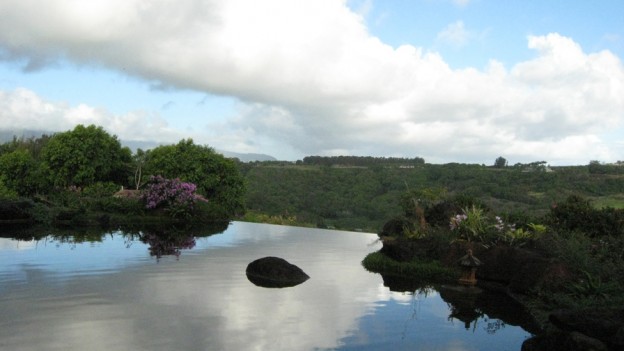
Infinity Pond, Hawaii
The specifics of this design created several construction challenges. Among these were creating concrete reinforced small pedestals for each “floating stone” that allowed the steppingstones to be installed at a precise height. Each pedestal also needed to be hidden from view and therefore was intentionally made overly strong yet small.
The interface between the pond and the surfaces used for the foundation and the finish flooring needed to be ultra durable, waterproof, and compact. In this case several methods of redundant waterproofing were used.
The mechanical and hydraulic system utilized a combination of ionization, filtration, and ultraviolet to maintain water purity.
The client, a noted musician, utilizes his open air designed home to host his renowned parties and gatherings at pond side under both sunny and starry Kauai skies.

Salmon Creek/Waterfront Estate, Mercer Island, WA
Initial site development by building construction of this site left the natural creek in highly erosive deplorable condition. Restoration of the creek and shoreline was one major challenge. An additional shoreline beach was installed along with integrating all facets of the landscape, which ranged from detailed bridge stone masonry to planting.
Aesthetic challenges involved reinforcing the adjoining salmon stream,that experiences high winter fluctuations, with stone “armor” that contributed not only to fish habitat but the aesthetics of the entire project due to its high visibility. Major boulders were used to reinforced stream bank walls and support a brigade over a large culvert.
A single stone bridge was installed both for access and visual drama in a key part of the stream. The car bridge was built partially from stone masonry to remain in keeping with an old third world style and feel of the architecture.
Site management was provided to carefully manage waterfront work both for the sensitivity of the shoreline and the Eagle nesting spots in a single Doug fir tree on the shore line. The combination of EssentialSoils and organic maintenance strategies created a toxin free, sediment free condition.
A diverse assortment of planting types was used for habitat and visual expression of color contrast and texture. In some cases special field transplanted contorted pines were used to fit into specific spots between stones to appear windswept.

Television 1
We don’t design the commonplace. We don’t believe in kits. Like fingerprints, snowflakes, and the stripes of a zebra,every project is unique we don’t believe in kits project is unique Like fingerprints, snowflakes, and the stripes of a zebra,every.

Video 3
We don’t design the commonplace. We don’t believe in kits. Like fingerprints, snowflakes, and the stripes of a zebra,every project is unique we don’t believe in kits project is unique Like fingerprints, snowflakes, and the stripes of a zebra,every.
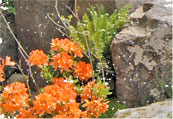
Video 2
We don’t design the commonplace. We don’t believe in kits. Like fingerprints, snowflakes, and the stripes of a zebra,every project is unique we don’t believe in kits project is unique Like fingerprints, snowflakes, and the stripes of a zebra,every.
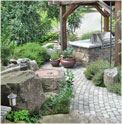
Medina Shore
We don’t design the commonplace. We don’t believe in kits. Like fingerprints, snowflakes, and the stripes of a zebra,every project is unique we don’t believe in kits project is unique Like fingerprints, snowflakes, and the stripes of a zebra,every.
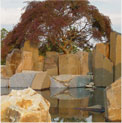
Galos Spa
We don’t design the commonplace. We don’t believe in kits. Like fingerprints, snowflakes, and the stripes of a zebra,every project is unique we don’t believe in kits project is unique Like fingerprints, snowflakes, and the stripes of a zebra,every.
